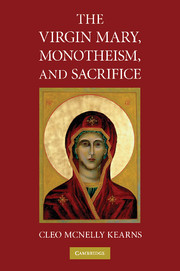Book contents
- Frontmatter
- Contents
- Preface
- Acknowledgments
- Introduction: A Vehement Flame
- PART ONE THEORIES OF SACRIFICE
- PART TWO MARY, MOTHERHOOD, AND SACRIFICE IN THE GOSPELS
- PART THREE MARY AND PRIESTHOOD
- 7 The Order of Melchizedek: Hebrews and Revelation
- 8 Mary, Priesthood, and Paternity in the Protoevangelion and the Qur'an
- 9 Eucharist and Ecclesia: Mary as Temple of the Temple
- Conclusion: Beyond Orthodoxy
- Notes
- Index
9 - Eucharist and Ecclesia: Mary as Temple of the Temple
Published online by Cambridge University Press: 27 July 2009
- Frontmatter
- Contents
- Preface
- Acknowledgments
- Introduction: A Vehement Flame
- PART ONE THEORIES OF SACRIFICE
- PART TWO MARY, MOTHERHOOD, AND SACRIFICE IN THE GOSPELS
- PART THREE MARY AND PRIESTHOOD
- 7 The Order of Melchizedek: Hebrews and Revelation
- 8 Mary, Priesthood, and Paternity in the Protoevangelion and the Qur'an
- 9 Eucharist and Ecclesia: Mary as Temple of the Temple
- Conclusion: Beyond Orthodoxy
- Notes
- Index
Summary
O temple, in which God became a priest, not changing our nature, but reclothing it, in his mercy, with that which he is, according to the order of Melchizedek.
ProclusEvery Mass puts us in intimate communion with her, the Mother, whose sacrifice “becomes present” just as the Sacrifice of her Son ‘becomes present’ at the words of consecration of the bread and wine pronounced by the priest.
John Paul IIThe figure of mary comes to the fore in emerging christian traditions in the context of a sacrificial discourse and a ramifying set of liturgical practices, literary typologies and figural relationships that join Christian self-understanding with the patriarchal narratives and temple cult of ancient Israel. Anthropologically speaking, as has been said, sacrifice in this new context not only recalls the Biblical discourse of sacrifice in the past but serves many of the same functions. It establishes gender distinctions, rectifies the otherness imported into the patriline by women, establishes a community, and marks the transmission of a distinct cultural and religious patrimony from spiritual “father” to spiritual “son.” Theologically speaking, it mediates the passions unleashed by human contact with the divine seen as a desiring and fathering God.
Sacrifice continues in this new Christian order, and it is not just the diffuse, celebratory sacrifice of feasting and celebration but the strong, agonistic sacrifice of suffering, ordeal, and expiation. At its heart is the eucharistic rite, variously known across Christian denominations as the “sacrifice of the mass” or the “Last Supper.”
- Type
- Chapter
- Information
- The Virgin Mary, Monotheism and Sacrifice , pp. 258 - 292Publisher: Cambridge University PressPrint publication year: 2008

